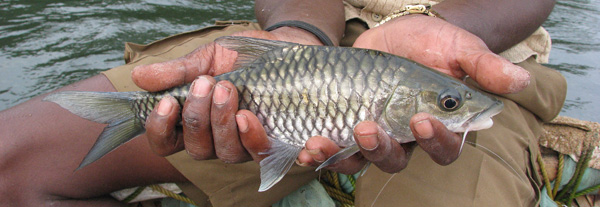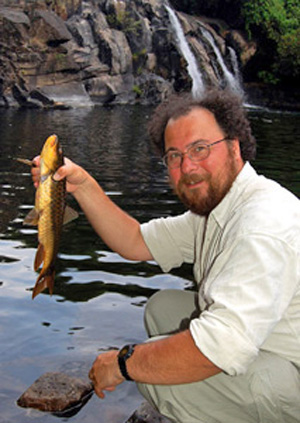When anglers up and down the UK were putting in their first casts of the new season on rivers, Mahseer Trust Press Officer, Steve Lockett was running lessons for a whole primary school for a full day.
With the theme of river conservation and special emphasis on Indian rivers, where mahseer live, the day was part of a growing programme called Our River, Our Life. Steve will be taking this education scheme into two schools in India later this year, alongside the Trust’s Indian Outreach Officer, Neethi Mahesh.
Steve told FishingMagic:
“By promoting better water use and, indeed, a greater awareness of the importance of clean water to all people across the globe, the Mahseer Trust is helping to change attitudes towards rivers. This can only be a good thing for entire river catchments and the habitats that mahseer need to thrive.”
The Mahseer Trust began life as a single-issue focus group, but has, over the last two years, widened its activities to encompass education, research and conservation to preserve rivers across south and southeast Asia. With members from seven different countries and scientific involvement from three continents, the Trust sees a major part of its remit as connecting those currently working on conservation in any area that has an impact on mahseer habitat.

Trust Director, Adrian Pinder of Bournemouth University said:
“Our most recent scientific research, during field visits to both south and north India in March and April revealed that there are lots of small mahseer in rivers across the country. This doesn’t mean we should be complacent, as there are multiple problems to address. The conservation challenges principally relate to a lack of basic knowledge regarding the taxonomy, biology, ecology and population status of various mahseer species and how to move the science forward in a positive manner.”
Mahseer is a generic term for fish of Tor species. Currently, it is believed that there are 18-20 different species in a range from Pakistan to China and south to Indonesia. Also included by some scientists are ‘Lesser’ mahseer of the Neolissichilus and Naziritor genus. India is home to the largest Tor, with fish from the River Cauvery capable of topping 100lb. These fish were previously considered to be Tor mussullah, but the validity of the scientific name is currently under question. Scientists are now calling this severely threatened fish the ‘golden’ or ‘orange-finned’ mahseer until such time that the genetic tests can determine exactly which species of mahseer it is.
One current theory about the status of the orange-finned mahseer is that the blue-finned mahseer, currently known as Tor khudree (but again the scientific name is subject to question) is breeding so successfully on the Cauvery that it is displacing its larger brethren. A planned field trip in February 2015 may help to unravel the mystery of the declining orange-finned and exploding blue-finned populations.
In August, Steve is heading to Indonesia and Malaysia to meet with locals who are breeding native mahseer and to see first-hand the forest village conservation schemes that could be used across the region.
Steve said:
“I have a particular fondness for Neolissichilus species, since finding a very rare one in the Amialla River in south India in 2007.They are the most stunning looking fish, and although never growing to the sizes of the true mahseer, the waters in which they live and the sheer beauty of the fish more than make up for lack of size”.
A contact of the Trust’s, Bing Hartoyo, trained as a fishery scientist in Indonesia. but on realising there was no money in local fisheries, he had to find work in marketing. On discovering the mahseer in his local river (probably Neolissichilus strachyii), were being fished out, he decided to do something about it. He set up his own breeding programme and with the agreement of the Fisheries Department, he now releases the fry into his local river. He has crucial knowledge about habitat and fish handling that can be shared across the region and the Trust looks forward to meeting Bing and learning more about Bing’s expertise.
 During Adrian’s visit to north India, he consulted with angling guides and villagers on the Ramganga River and together they concluded that encouraging subsistence fishing methods may be instrumental in reducing the destructive use of poisons and dynamite which are currently used to harvest mahseer. It is hoped that a major tackle manufacturer will assist by providing line and hooks so that a complete handline kit can be given away along with an instruction leaflet with pictures and both English and local language translations.
During Adrian’s visit to north India, he consulted with angling guides and villagers on the Ramganga River and together they concluded that encouraging subsistence fishing methods may be instrumental in reducing the destructive use of poisons and dynamite which are currently used to harvest mahseer. It is hoped that a major tackle manufacturer will assist by providing line and hooks so that a complete handline kit can be given away along with an instruction leaflet with pictures and both English and local language translations.
Also part of the Trust’s repertoire of activities is teaching kids in mahseer countries how to fish. Steve is a trained angling coach, and worked with the All India Game Fishing Association (AIGFA) to develop their coaching schemes. During the March and April visit, Steve helped with a three-day camp, attended by 30 kids aged 5 to 15. Then, on World Fish Migration Day (24 May), AIGFA and the Mahseer Trust ran a co-ordinated series of one-day camps in eight cities across India. This event introduced nearly 500 kids to angling and the fragility of aquatic ecosystems.
There are regular updates on the Trust’s website HERE at and on the Facebook group page. Members of the Trust also receive a yearly ezine containing articles and interviews directly related to the work they are supporting. Trust members will also get first refusal on tickets for fundraising events, details of which are announced on the Facebook page and Twitter feed.
Coming up in early August is a south Indian curry night at Looe Beach Café in Cornwall, in September there’s a dinner dance in Torquay, and then an evening with one of the Trust’s Patrons expected to be held in Hampshire towards Christmas time.










